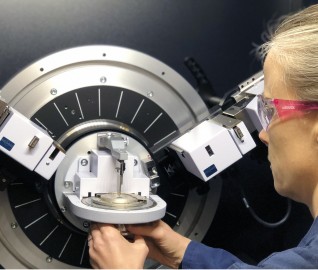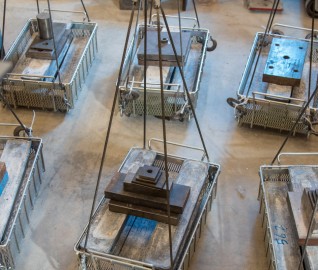This practice covers the procedure for determining the acceptability of concrete floors for the installation of resilient flooring. It also includes suggestions for ensuring that the constructed concrete floor is acceptable for such installations but does not cover tests for adequacy of the concrete floor to perform structural requirements. A permanent, effective moisture vapor retarder, of the specified thickness and permeance, is required under all on- or below-grade concrete floors. Concrete floors for resilient floorings should be permanently dry, clean, smooth, structurally sound, and free of substances that may prevent adhesive bonding. Surface cracks, grooves, depression, control joints or other non-moving joints, and other irregularities should be filled or smoothed with latex patching or a recommended underlayment compound. The surface of the floor should be cleaned by scraping, brushing, vacuuming, or any other method. All concrete slabs should be tested for moisture regardless of age or grade level while all concrete floors should be tested for pH before installing resilient flooring.
WJE laboratories are accredited by ANAB (ISO/IEC 17025) to perform testing standard ASTM F710 for Preparing Concrete Floors to Receive Resilient Flooring.
Contact us to learn more.
Keywords
ASTM F710 - Cement - Flooring and Floor Covering Systems - Resilient Flooring - Terrazzo Flooring
ICS CODE
91.060.30 (Ceilings. Floors. Stairs.); 97.150 (Nontextile floor coverings)
UNSPSC CODE
30111500 (Concrete and mortars); 30161700 (Flooring)
CITATION FORMAT
ASTM F710-19, Standard Practice for Preparing Concrete Floors to Receive Resilient Flooring, ASTM International, West Conshohocken, PA, 2019,
www.astm.org
 John E. Pearson, Principal and Laboratory ManagerWJE Northbrook MORE >People | John E. Pearson, Principal and Laboratory Manager
John E. Pearson, Principal and Laboratory ManagerWJE Northbrook MORE >People | John E. Pearson, Principal and Laboratory Manager WJE's Janney Technical Center (JTC) provides advanced testing and forensic capabilities to... MORE >Labs | Janney Technical Center
WJE's Janney Technical Center (JTC) provides advanced testing and forensic capabilities to... MORE >Labs | Janney Technical Center Our materials scientists provide comprehensive consulting services for the evaluation and... MORE >Services | Materials Evaluation and Testing
Our materials scientists provide comprehensive consulting services for the evaluation and... MORE >Services | Materials Evaluation and Testing WJE was founded on a spirit of innovation—that everything can be improved and that... MORE >Services | Product Development, Evaluation, and Testing
WJE was founded on a spirit of innovation—that everything can be improved and that... MORE >Services | Product Development, Evaluation, and Testing


































